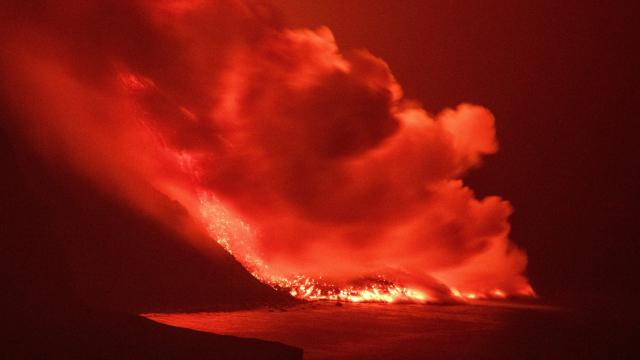The ongoing eruption of a Canary Islands volcano is raising concerns about the release of toxic clouds now that lava is actively pouring into the sea.
Lava in excess of 1,000 degrees Celsius is now plunging into the Atlantic Ocean, as Cumbre Vieja continues to erupt. Chemical reactions triggered by the union of hot lava and cool ocean water generate “laze” (a portmanteau of lava and haze), a dangerous mixture of steam, toxic gas (including hydrochloric acid), and tiny shards of volcanic glass. People living near the lava entry point are being asked to stay indoors given the health risks.

The eruption started on September 19, 2021, the result of fissures appearing on the western flanks of the Cumbre Vieja volcano. The volcano is located on the Spanish island of La Palma, which is home to nearly 85,000 residents.
Generous amounts of lava have been pouring down the volcanic slope, laying waste to homes, trees, farmland, and infrastructure (including many miles of roads). More than 6,000 people have had to evacuate, AFP reports, and to date more than 400 homes have been destroyed by lava, according to NASA Earth Observatory. The volcano continues to belch out large columns of smoke, resulting in ashfall and sulphur dioxide emissions. Nothing like this has been seen on La Palma since 1971.
Monitoreo del primer contacto de la lava con el medio marino. Buque oceanográfico #RamonMargalef @IEOoceanografia @CSIC pic.twitter.com/g3fiKsIA6E
— Eugenio Fraile (@EugenioFraile) September 29, 2021
From the moment lava began to flow, concerns were raised that the molten rock would eventually reach the Atlantic Ocean. These fears have now come true, as lava began to trickle into the ocean during the early hours of September 29, 10 days after the eruption started. The lava reached the ocean at an area known as Los Guirres beach or Playa Nueva.
Images taken from the Ramon Margalef, a research vessel operated by the Spanish Oceanography Institute, shows the red hot lava creeping into the ocean and the resulting clouds of volcanic fumes. The magma, as it solidifies, will likely reshape the coastline, extending the volcanic delta even farther.
Amanece en La Palma y comienza a formarse un delta de lava que poco a poco gana terreno al mar. pic.twitter.com/KNg6jy5Y4K
— Instituto Español de Oceanografía (@IEOoceanografia) September 29, 2021
Officials in La Palma have created an exclusion zone that extends for two nautical miles around the point where the lava was expected to reach the ocean. The Canary Islands Volcanology Institute issued a stern warning: “Inhalation or contact with acid gases and liquids can irritate the skin, eyes and respiratory tract, and may cause breathing difficulties, especially in people with pre-existing respiratory diseases.”
Cumbre Vieja shows no signs of letting up, and the eruption could last for several weeks or months. With toxic fumes now wafting through La Palma’s western coast, this natural disaster can’t end soon enough.
